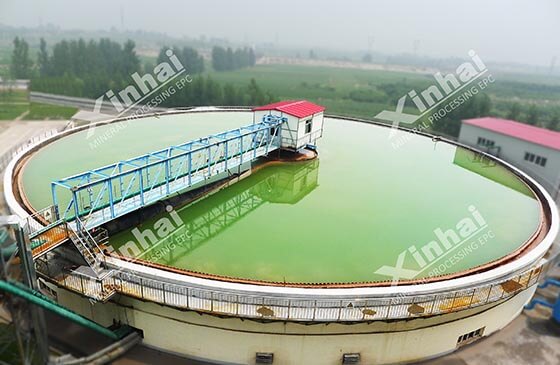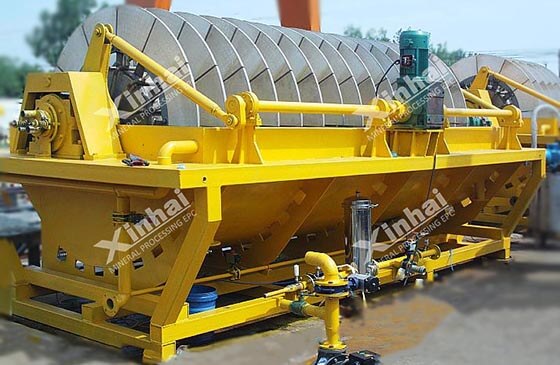

Warm Tip: If you want to know more details about equipment, solutions, etc, please click the button below for free consultation, or leave your requirements!
The water content of the concentrate is one of the standards to measure the quality of the concentrate.
Concentrate products produced by various wet beneficiation equipment contain a large amount of water, and the weight of water is often several times the weight of the dry concentrate. For example, the shaking table concentrate is about 5-9 times; the jig concentrate is about 2-7 times; the wet magnetic separation concentrate is about 2-5 times; the flotation concentrate is about 4-5 times.
In order to facilitate shipment, reduce freight and meet the needs of further processing, the moisture of the concentrate must be reduced to a certain standard. At the same time, reuse of backwater is also one of the ways to save water.
Therefore, the concentrate dewatering is of great significance in the beneficiation process.
In wet concentrators, dewatering operation is an indispensable auxiliary operation.
There are four types of moisture in concentrate products:
The part of the water that can flow freely under the action of gravity in the gap between solid particles is called gravity moisture. It is the easiest moisture to be removed in the material.
The solid particles form relatively small pores, which can produce capillary action. The water held in these tiny pores by capillary action is called capillary moisture.
Due to the dipole action of water molecules, a hydration film will be formed on the surface of the solid particles, and this part of the water is called film moisture. This is water that is more difficult to remove, and it is difficult to remove it even with strong centrifugal force.
Due to the adsorption on the surface of the solid particles, water molecules are adsorbed on its surface and reach the inside of the solid particles through osmosis.
The moisture attached to the surface of the particles is called adsorbed moisture; the moisture that penetrates into the particles is called absorption moisture, and the two are collectively called hygroscopic moisture. Even the use of heat to dry it can't eliminate it all.
According to the characteristics of the moisture of the material, we should use dewatering methods suitable for its nature. Since there are several kinds of water with different properties in the material at the same time, we often use several methods to cooperate with each other for dehydration.
The order of dehydration is easy first, then difficult, and from the outside to the inside. For gravity water, the methods of thickening, natural drainage or self-filtration can be used. That is to use the gravity of the solid particles or the water itself to dehydrate.
For the capillary moisture, we can use pressure difference or centrifugal force to separate the moisture from the solid particles, like forced filtration method.
As for the film moisture and hygroscopic moisture, only heating drying can be used.


According to the nature of the water content in the material, two-stage and three-stage dehydration processes are commonly used in concentrators at present, and the one-stage dehydration process is rarely used.
If the moisture limit of the concentrate product is not strict or the concentrate dehydration performance is good, it is relatively simple and economical to adopt the two-stage dehydration process of thickening and filtration.
For fine-grained concentrate products or where the moisture limit of concentrate products is strict, we should use the three-stage dehydration process, which includes thickening, filtration and drying.
However, the cost of drying operation is relatively high, and the loss of concentrate is large. Therefore, some processing plants in the cold place adopt two-stage dehydration in summer, and only use three-stage dehydration in winter (ice period).
Generally, the concentration of the product after thickening is about 40-60%; the moisture of the filter cake after filtration is 15-20%, and the individual easy-to-filter materials may be less than 10%; the moisture of the dried product is less than 10%. .
The above are the types of water contained in the beneficiation concentrate and the corresponding dehydration method. In actual production, you can choose the dehydration process suitable for your own beneficiation plant according to your own beneficiation technology and water content requirements to achieve the highest economic benefits.
If you have any questions about the content of this article, or want to design a dehydration process or purchase dehydration equipment, please contact the online customer service to communicate, or leave a message on the website, we will talk to you in detail as soon as possible.
Last: 5 Factors Affect Shaking Table Beneficiation
Next: 3 Commonly Used Dewatering Equipment for Beneficiation


What Are the Differences Between CIP and CIL?
 11364
11364
 0
0